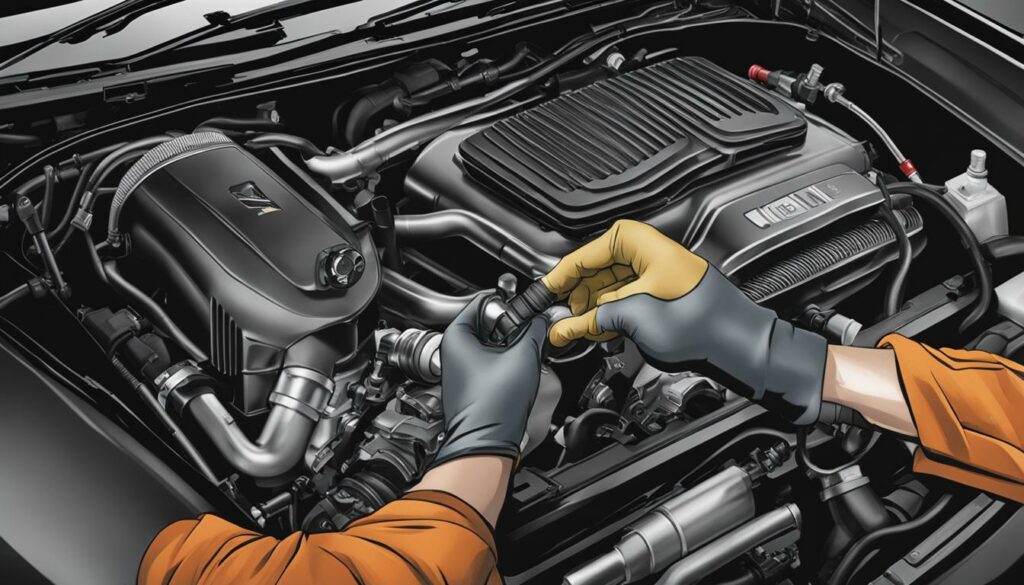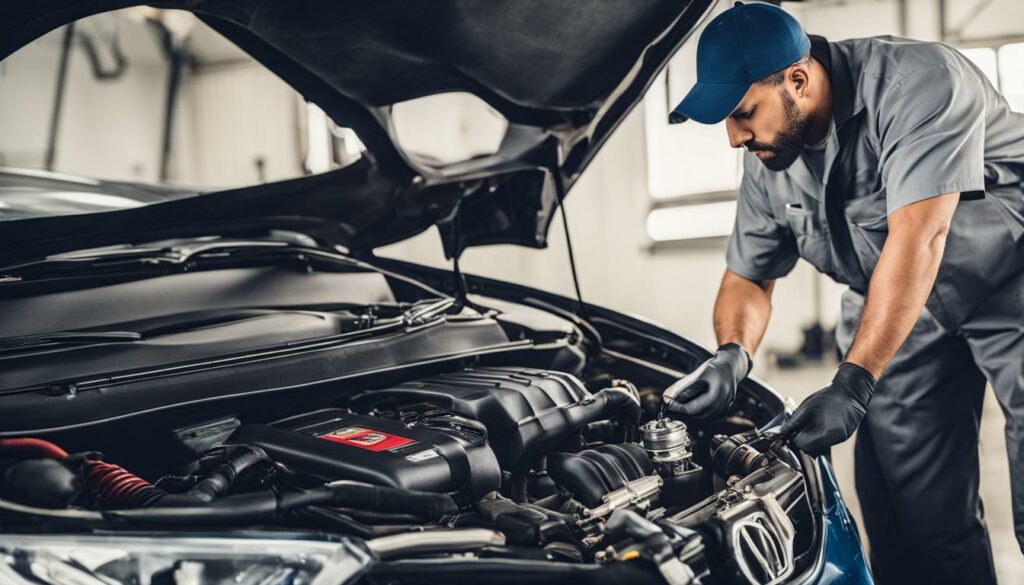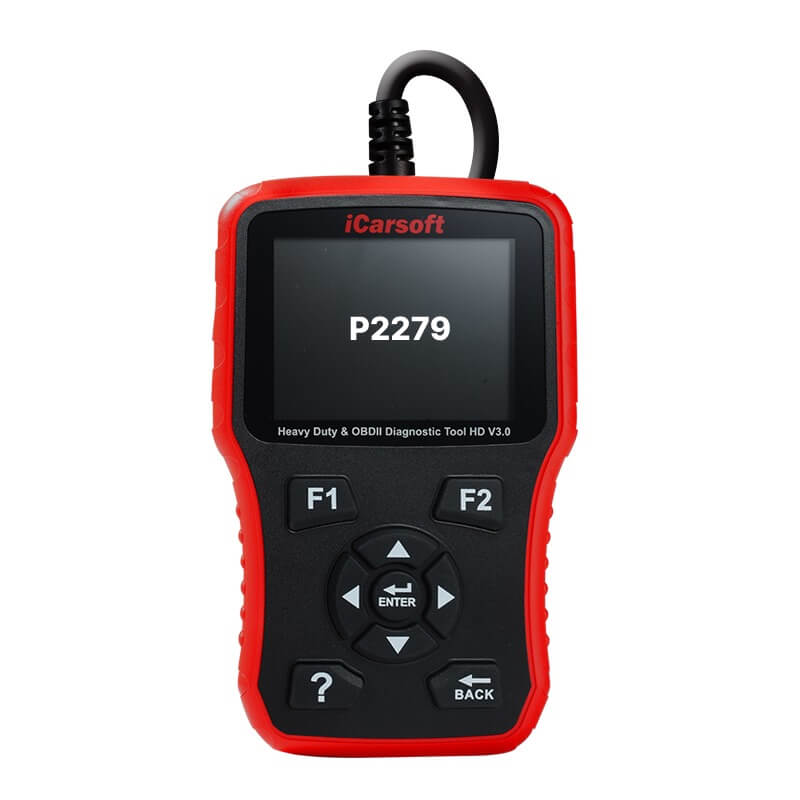P2279 – Airflow Leak Between MAF and Throttle Body
POSTED IN pcodes
In the world of automotive diagnostics, trouble codes are like secret messages sent by your car’s Engine Control Module (ECM) to alert you of a potential problem. One such code is P2279, which indicates an airflow leak between the Mass Airflow Sensor (MAF) and the Throttle Body.
Your car’s engine relies on the MAF or MAP sensor to accurately measure the amount of air entering the intake manifold. When there is a disparity between the mass airflow, intake air temperature, and oxygen sensor readings, the P2279 code is triggered. This can result in various symptoms, including engine stalling, lack of power, and even a lean air/fuel mixture.
Key Takeaways:
- P2279 is a trouble code indicating an airflow leak between the MAF and Throttle Body.
- This code can lead to symptoms such as engine stalling, lack of power, and a lean air/fuel mixture.
- Diagnostic and repair procedures involve conducting tests to identify the source of the leak and addressing it accordingly.
- Maintaining the air intake system is crucial for optimal engine performance and to prevent the occurrence of trouble codes like P2279.
- If professional assistance is not readily available, alternative solutions like specialized ECU programming can be explored.
Understanding the Implications of P2279
P2279 is an engine code that falls under the category of diagnostic trouble codes, specifically related to the powertrain. It is a generic code that applies to all makes and models of vehicles manufactured from 1996 onwards. When this code is triggered, it indicates the presence of an air leak on the “metered” side of the intake manifold. This means that unmetered air, which hasn’t been properly measured by the engine control unit (ECU), is entering the engine.
This air leak can have significant implications for the engine’s performance and efficiency. One of the key consequences is the disruption of the air-fuel mixture, which is essential for the combustion process. When unmetered air enters the engine, it creates a lean air-fuel mixture, meaning there is more air and less fuel than necessary for optimal combustion. This imbalance can lead to various symptoms and issues, such as reduced power, rough idling, engine misfires, and increased emissions.
Addressing and repairing the cause of the air leak is crucial to ensure proper engine operation and efficiency. Automotive repair professionals utilize diagnostic tools and procedures to identify the specific location and source of the air leak. Once identified, appropriate repair methods are implemented to rectify the issue and restore the air-fuel mixture to its optimal ratio.
Buy tested tuning file for Adblue / EGR / DPF / Adblue off now!
Significance of Diagnostic Trouble Codes (DTCs) in Automotive Repair
In the automotive repair industry, diagnostic trouble codes (DTCs) play a vital role in identifying and resolving issues with vehicle systems. These codes act as “clues” that help technicians pinpoint the underlying cause of a malfunction or problem. In the case of P2279, the code serves as an indicator of an air leak in the intake manifold, prompting technicians to investigate and address the issue.
Diagnostic tools, such as OBD-II scanners, enable technicians to retrieve DTCs from a vehicle’s ECU. These codes provide valuable information about the nature and location of the problem, allowing technicians to take precise diagnostic measures and execute appropriate repairs. By understanding and interpreting DTCs accurately, automotive professionals can efficiently diagnose and fix various engine and component-related issues, ensuring optimal vehicle performance and customer satisfaction.
Proper Diagnostic and Repair Procedures for P2279
When faced with a P2279 code, it is essential to follow proper diagnostic and repair procedures to achieve successful resolution. The table below outlines the recommended steps for addressing a P2279 code:
| Step | Action |
|---|---|
| 1 | Retrieve the P2279 code using an OBD-II scanner |
| 2 | Inspect the air intake system for any visible leaks or damage |
| 3 | Perform a smoke test to identify hidden or hard-to-detect air leaks |
| 4 | Inspect the intake air temperature sensor, throttle body, and intake manifold for potential leaks or malfunctions |
| 5 | Address and repair any identified leaks or malfunctions |
| 6 | Erase the P2279 code and reset the ECU using an OBD-II scanner |
Following these diagnostic and repair procedures, in conjunction with the expertise of automotive repair professionals, is essential in resolving the P2279 code accurately and effectively.
Symptoms of P2279
The symptoms of a P2279 engine code can vary depending on the severity of the air leak. Common symptoms include:
- Illumination of the Malfunction Indicator Lamp (MIL)
- Stalling at a stop
- Idle surges
- Lack of power
- Dead spots on acceleration
- Engine “pinging” due to a lean air/fuel mixture
Additionally, cherry red exhaust manifolds and a hissing sound produced by the air leak may also be observed. It is important to address these symptoms promptly to avoid further damage to the engine and ensure optimal performance.
Regular car maintenance, including inspections of the air intake system, can help detect and prevent airflow leaks.
Common Causes of P2279
There are several common causes that can contribute to the occurrence of a P2279 code. These causes include:
- Leak between MAF and air duct: A leak between the engine side of the mass airflow sensor (MAF) and the air duct can lead to unmetered air entering the intake manifold. This can result in a disrupted air/fuel mixture and trigger a P2279 code.
- Leak at intake air temperature sensor or throttle body: An air leak at the intake air temperature sensor or throttle body can also cause the P2279 code to be triggered. These components play a crucial role in measuring and regulating the airflow, and any leaks can disrupt the proper functioning of the intake system.
- Crack or leak in the intake manifold: A crack or leak in the intake manifold can allow unmetered air to enter the engine, resulting in a P2279 code. Inspecting the intake manifold for any cracks or leaks is an important troubleshooting step.
- Disconnected or broken vacuum hoses: Vacuum hoses play a vital role in regulating the airflow in the engine. If these hoses become disconnected or broken, it can cause air leaks and trigger a P2279 code.
- Bad fuel injector seal at the manifold: A faulty seal on the fuel injector at the manifold can lead to air leaks and trigger a P2279 code. Ensuring proper seals and connections are in place is crucial for optimal engine performance.
- Leaky brake booster vacuum hose: The brake booster vacuum hose is another potential source of an air leak. If this hose is leaking, it can contribute to the occurrence of a P2279 code.
- Leak under the dash at a vacuum-operated device: Lastly, a leak under the dash at a vacuum-operated device can also lead to unmetered air entering the engine and trigger a P2279 code.
When troubleshooting a P2279 code, it is important to inspect and test these components for leaks or malfunctions. Repairing or replacing any identified issues can help resolve the cause of the air leak and resolve the P2279 code.
Consulting repair manuals or seeking professional assistance is recommended for accurate diagnosis and repair.

| Possible Causes of P2279 | Troubleshooting Steps |
|---|---|
| Leak between MAF and air duct | Inspect and repair any leaks between the MAF and air duct. Ensure a proper seal and connection. |
| Leak at intake air temperature sensor or throttle body | Inspect the intake air temperature sensor and throttle body for any leaks. Repair or replace as necessary. |
| Crack or leak in the intake manifold | Inspect the intake manifold for any cracks or leaks. Repair or replace the manifold if necessary. |
| Disconnected or broken vacuum hoses | Check all vacuum hoses for proper connections and any signs of damage. Repair or replace as needed. |
| Bad fuel injector seal at the manifold | Ensure the seals on the fuel injectors at the manifold are properly sealed. Replace any faulty seals. |
| Leaky brake booster vacuum hose | Inspect the brake booster vacuum hose for any leaks. Repair or replace the hose if necessary. |
| Leak under the dash at a vacuum-operated device | Check for any leaks under the dash at vacuum-operated devices. Repair or replace as needed. |
Diagnostic and Repair Procedures for P2279
To effectively diagnose and repair a P2279 code, it is essential to follow specific procedures. By adhering to these steps, you can accurately locate the source of the air leak and ensure an effective resolution.
Here are the troubleshooting steps for diagnosing and repairing a P2279 code:
- Listen for Whistling Sounds: Start by carefully listening for any whistling sounds coming from under the hood. Whistling sounds may indicate a potential air leak.
- Perform a Propane Test: Direct a small amount of propane towards the suspected devices to identify the location of the leak. Pass the propane hose around the air ducts leading up to the throttle body and intake manifold. This will help pinpoint the source of the air leak.
- Check for Interior Vacuum Leaks: Pay attention to any interior vacuum leaks that may be present under the dash. These leaks can contribute to the P2279 code.
- Correct the Leak: Once the air leak has been identified, take the necessary steps to correct it. This may involve repairing or replacing the affected components, such as the intake air temperature sensor, throttle body, or intake manifold.
- Erase the Code and Reset the Engine Control Module (ECM): After addressing the air leak, use a code scanner to erase the P2279 code and reset the engine control module. This step ensures that the code is cleared from the system.
Following these diagnostic and repair procedures will help you resolve the P2279 code and restore optimal engine performance. Remember to consult repair manuals or seek professional assistance for accurate diagnosis and repair.
Note: Proper safety precautions should always be followed when working on vehicles. If you are not experienced in automotive repair, it is recommended to seek professional assistance.
Professional Assistance for P2279
In cases where professional assistance is not readily available or required, an alternative solution for resolving a P2279 code is by permanently removing the code from the Engine Control Unit (ECU). This can be done by uploading the ECU file to a portal that specializes in ECU programming. The file is modified to eliminate the P2279 code and its associated functions. It is crucial to ensure that the modified programming is compatible with the vehicle and does not have any adverse effects on engine performance or efficiency. Consultation with automotive repair professionals and experts is recommended to make an informed decision regarding this alternative solution.

Professional assistance can provide the expertise and technical knowledge required to diagnose and resolve complex engine issues like the P2279 code. By consulting with automotive repair professionals, you can access their years of experience and industry insights to accurately diagnose the root cause of the problem. They have access to specialized diagnostic equipment, ensuring a thorough examination of key components such as the MAF sensor, throttle body, and intake manifold.
Additionally, professional assistance ensures that proper repair procedures are followed, minimizing the risk of further damage to the engine. They can recommend the appropriate repair strategy for resolving the specific issue causing the P2279 code, whether it involves repairing a vacuum leak, replacing faulty sensors, or addressing other underlying problems.
Furthermore, seeking professional help provides peace of mind, as reputable automotive repair shops typically offer warranties or guarantees on their work. This means that if any issues persist after the repair, you have assistance and support readily available.
In summary, professional assistance for P2279 not only offers the necessary expertise and technical knowledge but also ensures a thorough diagnosis and proper repair procedures. By relying on the skills of automotive repair professionals, you can effectively resolve the P2279 code and restore optimal engine performance.
Importance of Maintaining the Air Intake System
The air intake system is a crucial component for optimal engine performance and efficiency. It plays a vital role in delivering the necessary amount of air to the engine for combustion, ensuring proper fuel-air mixture and power generation. However, any leaks or malfunctions in the air intake system can disrupt this process, leading to decreased engine performance and potential damage.
Regular maintenance and inspections of the air intake system are essential in order to detect and address potential issues promptly. This includes checking for cracks or breaks in hoses, ensuring proper connections, and replacing any damaged components. By maintaining the air intake system, car owners can optimize engine performance, enhance fuel efficiency, and prevent the occurrence of diagnostic trouble codes like P2279.
Periodic inspections allow for the early detection of airflow leaks or other problems that could negatively impact engine performance. By addressing these issues promptly, car owners can avoid potential consequences such as decreased power, rough idling, or poor fuel economy.
Moreover, maintaining the air intake system is a cost-effective way to prevent more extensive engine damage. By ensuring that the air intake system is operating optimally, car owners can reduce the risk of wear and tear on other engine components, potentially saving on expensive repairs in the long run.
“Regular maintenance and inspections of the air intake system are essential to detect and address potential issues, such as airflow leaks.”
Car owners should also keep in mind that a well-maintained air intake system contributes to a cleaner and healthier engine. Proper airflow and combustion minimize the production of harmful emissions, promoting a greener driving experience and reducing environmental impact.
In conclusion, maintaining the air intake system is crucial for preserving engine performance, maximizing fuel efficiency, and preventing the occurrence of diagnostic trouble codes. By conducting regular inspections and addressing any issues promptly, car owners can ensure the longevity and reliability of their vehicles.
Conclusion
In conclusion, the P2279 engine code indicates an airflow leak between the mass airflow sensor (MAF) or throttle body and the intake manifold. This issue can result in various symptoms, including engine stalling, lack of power, and a lean air/fuel mixture. It is crucial to address this problem promptly to prevent further damage to the engine and ensure optimal performance.
The common causes of P2279 include leaks in the intake air system, such as at the intake air temperature sensor, throttle body, or intake manifold. To diagnose and repair this code, it is necessary to inspect and test these components to identify and resolve the source of the air leak. Additionally, regular maintenance and inspections of the air intake system are vital for maintaining optimal engine performance and efficiency.
If professional assistance is not readily available, there is an alternative solution for permanently removing the P2279 code. This involves specialized ECU programming to modify the engine control unit (ECU) file, ensuring compatibility with the vehicle and avoiding any adverse effects on engine performance. Consulting with automotive repair professionals is recommended to make an informed decision about this alternative solution.
To maintain a healthy engine and avoid the occurrence of diagnostic trouble codes like P2279, car owners should prioritize regular maintenance and inspections of the air intake system. By detecting and addressing potential airflow leaks promptly, they can optimize engine performance, ensure fuel efficiency, and prolong the life of their vehicles.
FAQ
What does the trouble code P2279 indicate?
The trouble code P2279 indicates an air leak on the “metered” side of the intake manifold, typically between the mass airflow sensor (MAF) or MAP sensor and the throttle body.
What are the symptoms of a P2279 engine code?
Symptoms of a P2279 engine code may include MIL illumination, stalling, idle surges, lack of power, engine “pinging,” cherry red exhaust manifolds, and hissing sounds from air leaks.
What are some common causes of a P2279 code?
Common causes of a P2279 code include leaks at the intake air temperature sensor, throttle body, or intake manifold, as well as cracked or disconnected vacuum hoses and leaky brake booster vacuum hoses.
How is a P2279 code diagnosed and repaired?
Diagnostic and repair procedures for a P2279 code involve conducting a propane test, checking for interior vacuum leaks, and repairing any identified issues in the air intake system or associated components.
What should I do if I need professional assistance for a P2279 code?
If professional assistance is needed for a P2279 code, it is recommended to consult with an automotive repair professional who can accurately diagnose and resolve the issue.
Why is it important to maintain the air intake system?
Maintaining the air intake system is important to optimize engine performance, ensure fuel efficiency, and prevent the occurrence of airflow leaks like the one indicated by a P2279 code.
How can I permanently remove a P2279 code from the Engine Control Unit (ECU)?
Permanently removing a P2279 code from the ECU can be done through specialized ECU programming, but it is recommended to consult with automotive repair professionals and experts to ensure compatibility and avoid adverse effects on engine performance.


